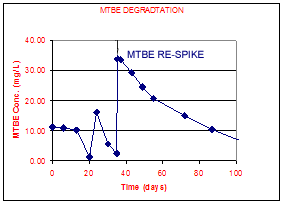More Info...
|
News Archives
IESI Leads The Way With New Bioremediation Approaches & Cultures
February 2, 2007
Degrading MTBE
Our BW-05 aerobic culture can degrade MTBE (as the sole carbon source) in-situ or ex-situ. For In-situ application, the culture is introduced into an aerobic zone (ex. area of air sparging). For ex-situ treatment the GAC columns (must be pressure rated) can be seeded with our culture to maximize MTBE removal and minimize GAC consumption.
MTBE DEGRADER (BW-05)

Degrading 1,1,1 TCA
Bioremediation of 1,1,1 TCA (TCA) is significantly more challenging than bioremediation of tetrachloroethene (PCE) and trichloroethene (TCE) series compounds. Our experience over the past eleven years, at over 20 enhanced bioremediation TCA impacted sites indicates that TCA degradation will generally occur after PCE and TCE series compound degradation has generally been completed (or mostly completed). One can generally dechlorinate PCE and TCE with almost any electron donor (lactate, molasses, vegetable oil etc.), but our work has clearly indicated there is a real electron donor preference with TCA degradation. In many instances, these same electron donors will work for TCA dechlorination, however we have observed several project sites where whey is the only electron donor that will stimulate TCA dechlorination. These have tended to be mixed solvent and high TCA concentration sites. We have speculated that whey contains cofactors that speed up the dechlorination process. The breakdown of whey (which contains proteins and other complex compounds) also generates more electrons (generating more reducing conditions) than the break down of simple organic acids such as lactate which may be another important factor. No other firm in the US possess our experience and knowledge when it comes to degrading 1,1,1 TCA.
Dechlorination in Toxic/Inhibitory Zones
While all of our competitors struggle with bioremediation in high VOC concentrations zones and are still looking for answers, we have been doing this work for ten years (and never thought it was difficult or worth advertising!). Our work has enabled us to successfully degrade up to 550 mg/L of PCE to ethene in the laboratory and in the field by acclimating our NJ-14 culture. We also practice groundwater detoxification and groundwater mixing as viable options to reduce VOC concentrations to the biodegradable range. Bioremediation of highly contaminated/inhibitory/toxic zones is truly one of our areas of expertise that is simply unmatched across the world. We have successfully bioremediated sites with VOC concentrations in the thousand of mg/L
Degrading Perchlorate
We have bioremediation cultures capable of fully degrading perchlorate within days of acclimation.
For more information contact:
(508) 623-1221
info@IESIOnline.com
IESI Develops Efficient Bacterial Culture to Degrade 1,4 -Dioxane
September 23, 2004
Innovative Engineering Solutions Inc. (IESI) has developed a new, more cost effective, in-situ bioremediation technique for the destruction of 1,4 Dioxane, a widely distributed groundwater contaminant commonly used as a solvent stabilizer, especially with 1,1,1Trichloroethane.
At an IESI project site in Salt Lake City, Utah, the IESI team cultured a propanotroph (SL-D), an organism that can utilize propane as a sole carbon source. Site analysis demonstrated that SL-D can aerobically degrade at least 10 mg/L of 1,4 Dioxane within hours of application. The IESI team is currently evaluating the extent to which microorganisms like SL-D are present at other project sites, and the extent to which the 1,4 Dioxane is utilized for growth by the organism.
SL-D is more reactive and cost-effective than other treatment techniques. Typically, 1,4 Dioxane does not respond well to traditional technologies such as carbon adsorption or air stripping. Even the most common treatment method for 1,4 Dioxane contaminated groundwater -- ex-situ treatment using UV-hydrogen peroxide oxidation -- is very costly.
The SL-D culture is currently available for potential bioaugmentation in full-scale applications. IESI has also developed techniques for the enrichment of native propanotrophs and engineered a safe and reliable dissolved propane subsurface delivery system.
Since 1995, IESI, a leading provider of environmental consulting services for the remediation of contaminated properties, has been specializing in the design and implementation of bioremediation systems for chlorinated volatile organics (CVOCs).
IESI has evaluated hundreds of sites, and is currently involved in over 40 full-scale enhanced anaerobic dechlorination and bioaugmentation projects utilizing injection of cultured bacteria (when needed) for the degradation of contaminants.
For more information contact:
(508) 623-1221
info@IESIOnline.com
|
